Evaluating and Managing Pricing Talent
No pricing strategy can be successfully executed without the help of the right talent in key positions. As recently as 10 years ago, prices were primarily set by salespeople, marketers, or product managers. Today, more and more companies recognize that pricing activities require unique skills, ranging from the ability to perform complex analytics using the latest technological tools to assessing price elasticity in a volatile marketplace.
Organizations have also increasingly grasped that pricing professionals need to straddle different functions. Thus, individuals with experience across Sales, Marketing, and Finance can prove invaluable. Because mature pricing professionals are still a relatively scarce resource, many businesses recruit them from other companies. But some companies are putting programs in place to nurture their talent. The most successful of these companies make their pricing specialists highly visible and reward them for what is increasingly viewed as a strategic position.
An effective talent management program enables a company to:
- ensure the company has the right expertise to execute its pricing strategy
- equip candidates for pricing positions with the appropriate training so they are capable of implementing the improved practices
- create viable career paths
- identify promising candidates to develop
- retain high-performing talent.
Whether it is within the Sales function or in other functions, Pricing should be established as a distinct discipline within the organization by:
- developing methods for attracting and recruiting new talent
- deploying pricing talent within the organization in roles that enable professionals to reach their full potential
- involving pricing managers in decision making and design activities to increase their sense of ownership
- providing pricing resources to employees along with professional development opportunities to keep them up to date on market trends.
Evaluating Current Talent
When assessing an organization's talent needs, management must first assess what pricing skills it currently has in-house in the five core competencies:
- price execution
- pricing strategy
- pricing analytics
- pricing technology
- tax and regulatory effectiveness.
A gap analysis should be performed to determine which of these core competencies might be missing within the current resource pool (see Figure 6.9). Management should then create a plan to fill those gaps as illustrated in the talent management roadmap in Figure 6.10.
Figure 6.9 Current Employee Skill Set Gap Analysis
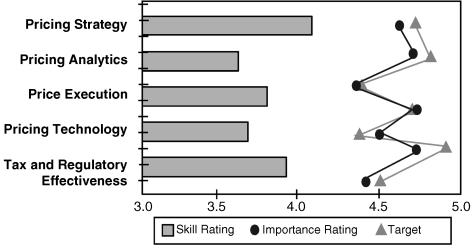
Figure 6.10 Talent Management Road Map
BU, Business Unit; CWS, Critical Workforce Segments; HR, Human Resources; TM, Talent Management; TR, Training; TRA, Training Requirements and Audience.

Developing a Talent Management Strategy
As with other employees, pricing professionals want to understand what career paths are open to them, and which skills are needed to advance. A firm's talent strategy should achieve the following.
•Define a pricing career path. The career development framework (see Figure 6.11) provides the steps employees can take to build their pricing experience and skill sets to advance within a pricing organization. The framework specifies rewards as well as opportunities for promotion.
Figure 6.11 Career Development Framework
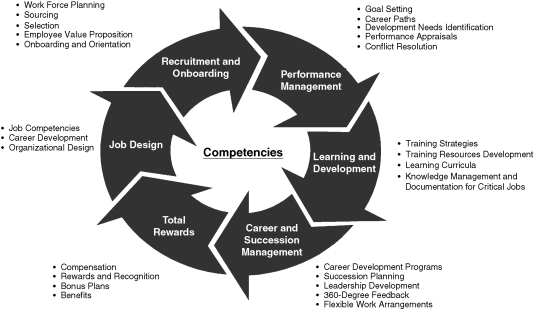
•Create customized training and leadership development programs. Pricing curricula should be tailored to the specific needs of an organization and include a recommended timeline for completing courses in sequential order as well as benchmarks to track the progress employees make in developing their skill sets. In addition, employees must be offered access to formal leadership programs.
•Offer professionals attractive compensation, awards, and recognition. Companies need to ensure that pricing professionals are offered the same rewards and incentives for performance as their colleagues in more established functions.
The talent management plan should establish pricing as a lucrative career path if it is to succeed in attracting and retaining the most skilled professionals. The plan should signal the importance of the discipline to the organization by requiring all high-potential employees to fulfill a pricing role during their tenure, as a developmental experience. Positions can be found for entry-level, mid-level, and executive employees (see Figure 6.12).
Figure 6.12 Pricing as a Career
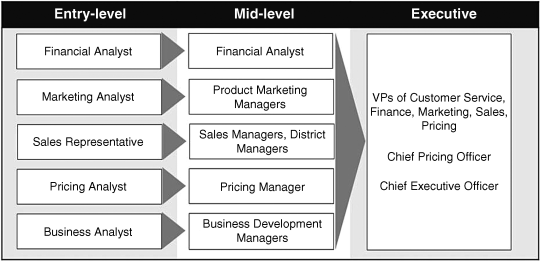
Pricing can provide employees with:
- Rotational assignments that facilitate cross-functional learning
- An understanding of business economics
- More developed and refined analytical skills.
In a 2009 study of 317 pricing professionals,2 many reported having moderate to substantial organizational status and influence: 81 percent of study participants were in middle management or above, and 42 percent were VPs, directors, or C-level executives. These results suggest pricing will continue to evolve as a long-term career choice with compensation commensurate to the high-level skills and responsibilities the discipline requires (see Figure 6.13).
Figure 6.13 Distribution of Pricing Roles
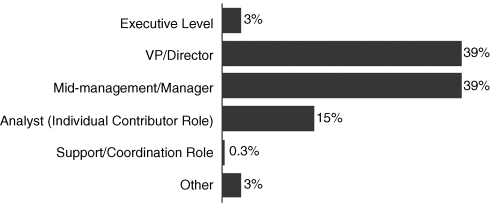
In that same survey, 85 percent of the respondents “agreed” or “strongly agreed” that their current pricing role was a “very strong” career enhancer (see Figure 6.14). This finding indicates that business professionals find this growing discipline attractive and suggests that, in coming years, companies should be able to find, develop, and retain the talent they need to execute and manage their pricing transformations successfully.
Figure 6.14 Responses to Survey Question “I Consider My Pricing Role to be a Strong Career Enhancer”
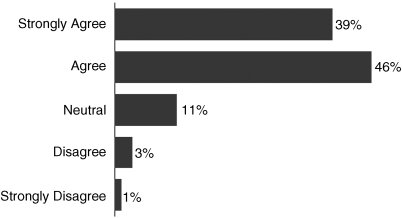
Managing Cross-Country Pricing Cultures
Although pricing is and should be treated as a core competency throughout any business, multinational organizations face particular challenges. Even those that have implemented consistent pricing strategies within a given country or region may find it difficult to do so across borders. In fact, a one-size-fits-all approach rarely works in international markets that operate under very different conditions and dynamics. Even a question as seemingly basic as when to apply end-of-life pricing to a mature product can vary significantly from country to country. For example, a major durable goods manufacturer wanted to retire a particular technology across the U.S. and Europe, but got pushed back from its leaders in two countries where the product was still viable and carried a high price premium. If the company had attempted to force uniform pricing across all countries, then it would have missed out on significant revenue.
In some countries, local cultural practices simply will not change in response to a directive from a U.S.-based headquarters. In the U.S., receivables are typically paid within 60 days. But in other countries, average receivables age can exceed 700 days. To a U.S. pricing manager that represents millions of dollars in additional cash flow. However, a local pricing professional would state—correctly—that to attempt to change the business culture to one in which bills are paid more promptly would be a futile endeavor, and the attempted change could cause significant harm to a company's reputation and its ability to conduct business.
Where possible, effective pricing practices should be shared across geographies. A key component to doing this successfully is to acknowledge that these practices need to be customized to fit the specific culture of each country. This can be achieved through both incentives and pricing roles.
For example, a pricing initiative that includes revising incentive pay (for both management and sales) to better align with pricing profitability objectives must take into account the different cultural and legal and regulatory requirements that exist within each country. How incentives are aligned in Japan, where the culture may be to use more team rewards and smaller amounts, may differ from the approach in the U.S., where individuals are often motivated by large, personal rewards. In China, for example, the local practice may be to allow companies to use more variable-based compensation schemes instead of salaries, whereas in Germany and France, firms would consult with national work councils to design and implement compensation structures.
Similarly, a multinational company undertaking an initiative to improve pricing may consider changes to the global organization. At the country level this might mean looking at job titles and job structures. In Europe, one might find an organization that is led by managing directors in key countries. In emerging markets (e.g., Eastern Europe, Africa, and South America) firms might set up pricing organizations that are much more autonomous and entrepreneurial in structure to support the opportunistic nature of these regions and to seize their evolving market opportunities.
